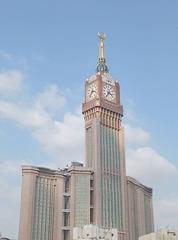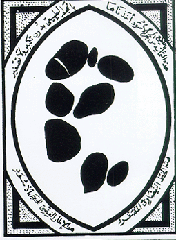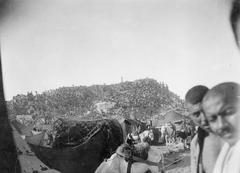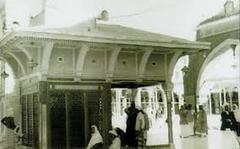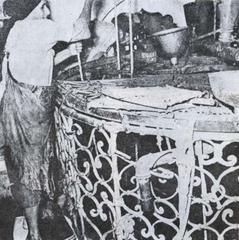Jamaraat Bridge Visiting Hours, Tickets, and Comprehensive Travel Guide – Mecca, Saudi Arabia
Date: 14/06/2025
Introduction
The Jamaraat Bridge in Mina, Mecca, is one of the most significant pilgrimage sites for Muslims globally, serving as the focal point for the ritual of Ramy al-Jamarat (the symbolic stoning of the devil) during the annual Hajj. This comprehensive guide offers a detailed overview of the bridge’s religious significance, historical evolution, architectural innovations, visiting hours, ticketing policies, accessibility features, safety protocols, and practical travel tips. Whether you are a first-time pilgrim or a returning visitor, this resource will help you prepare for a safe, meaningful, and spiritually fulfilling journey.
Table of Contents
- Origins and Historical Development
- Religious Significance in Islamic Tradition
- Architectural Transformation and Milestones
- Visiting the Jamarat Bridge: Practical Information
- The Bridge in Contemporary Pilgrimage
- Safety Features and Innovations
- Accessibility and Facilities
- Nearby Attractions in Mina and Mecca
- Practical Visitor Tips
- Frequently Asked Questions (FAQ)
- Conclusion and Further Resources
- Official Sources
Origins and Historical Development
Early Roots of the Jamarat Ritual
The ritual of stoning the three jamarāt in Mina traces its origins back to Prophet Ibrahim (Abraham), who, according to Islamic tradition, rejected the devil’s temptations by symbolically throwing stones at him. This act is commemorated by millions of pilgrims each year and is integral to Hajj (hajjcouncil.org).
Evolution of the Ritual Site
Originally, the ritual was performed at three stone markers. As the number of pilgrims increased over centuries, these markers were transformed into more substantial structures, eventually leading to the multi-level Jamaraat Bridge to accommodate the growing crowds and ensure safety (wikipedia).
Religious Significance in Islamic Tradition
Symbolism and Spiritual Meaning
Ramy al-Jamarat, performed from the 10th to the 13th of Dhu al-Hijjah, is more than a physical act; it symbolizes the rejection of evil and the reaffirmation of faith. The act of stoning the jamarāt recalls Prophet Ibrahim’s steadfastness and is a collective expression of unity among Muslims, highlighting the equality and shared purpose of all participants, regardless of background (hajjcouncil.org; 3rooj.com).
Architectural Transformation and Milestones
Early Infrastructure and Challenges
Initially marked by simple stone pillars, the site became increasingly congested as pilgrim numbers rose, leading to tragic incidents and prompting the need for modern infrastructure. The first bridge structure was constructed in 1963, but it soon became insufficient (atlasislamica.com).
Major Redevelopment (2006–2011)
In response to safety concerns, the Jamaraat Bridge was redeveloped into a five-level structure capable of handling up to 600,000 pilgrims per hour. The bridge now features:
- Five expansive levels with segregated entrances and exits
- Padded concrete walls replacing original pillars for safety
- Advanced crowd control systems, escalators, and elevators
- Dedicated emergency service areas and helicopter pads (theworldfolio.com; wikipedia)
Visiting the Jamarat Bridge: Practical Information
Visiting Hours
The bridge is open exclusively during the Hajj season, especially from the 8th to the 13th of Dhu al-Hijjah, aligning with the ritual schedule. Access is primarily during the day, with authorities managing entry times to reduce congestion. Outside the Hajj period, the bridge is generally closed to the public.
Tickets and Entry
No separate tickets are required. Access to the bridge is included in the Hajj permit. Entry is strictly regulated to eligible pilgrims with valid Hajj credentials (banbanjara.com).
The Bridge in Contemporary Pilgrimage
Central Role in Hajj
Located in Mina, around 8 kilometers from the Kaaba, the Jamaraat Bridge is a central element in Hajj logistics. Its advanced design facilitates the smooth movement of millions of pilgrims between ritual sites (3rooj.com).
Impact on Pilgrim Experience
Modernization has improved safety, accessibility, and comfort, allowing pilgrims to focus on spiritual fulfillment. Medical and crowd management teams are present throughout the site (welcomesaudi.com; trek.zone).
Safety Features and Innovations
- Multi-Level Structure: Reduces crowd density.
- One-Way Flow: Clear signage and barriers prevent counterflows.
- Surveillance: Real-time monitoring ensures prompt intervention.
- Emergency Facilities: Dedicated routes for vehicles and medical teams; helicopter pads for evacuation.
- Environmental Controls: Shaded walkways, air conditioning, water misting, and Zamzam water stations (ebaraeurope.com).
Accessibility and Facilities
- Elevators & Ramps: All levels are accessible to the elderly and differently-abled.
- Rest Areas: Multiple zones for rest, hydration, and prayer.
- Sanitation: Ample restrooms and washing facilities.
- Support Services: First aid, lost and found, multilingual information desks (banbanjara.com).
Nearby Attractions in Mina and Mecca
- Mina Tent City: Air-conditioned tents for pilgrims.
- Mount Arafat: Central to Hajj rituals.
- Cave of Hira & Jabal Thawr: Important historical sites.
- Masjid al-Haram: The holiest mosque, housing the Kaaba.
- Makkah Museum & Clock Tower Museum: For cultural exploration.
- Zamzam Well: Revered source of water (thrillophilia.com).
Practical Visitor Tips
- Plan Ahead: Book accommodation and transport early.
- Dress Appropriately: Modest attire and sturdy footwear.
- Stay Hydrated: Use provided water points.
- Follow Instructions: Adhere to signage and crowd control measures.
- Be Aware: Familiarize yourself with emergency exits.
Frequently Asked Questions (FAQ)
Q: What are the Jamaraat Bridge visiting hours?
A: The bridge is accessible during Hajj from the 8th to 13th of Dhu al-Hijjah, mainly during daylight hours. Outside Hajj, it is closed to the public.
Q: Do I need a ticket to access the Jamaraat Bridge?
A: No ticket is required; a valid Hajj permit grants access.
Q: Is the bridge accessible for disabled pilgrims?
A: Yes, with ramps, elevators, and designated pathways.
Q: What safety measures are in place?
A: Multi-level design, surveillance, real-time crowd control, emergency medical teams, shaded walkways, and clear signage.
Q: Are there accommodation and food facilities nearby?
A: Accommodation is in Mina’s tent city; food and water are available within the camps, with hotels in nearby Azizia and Mecca.
Conclusion and Further Resources
The Jamaraat Bridge is not just a structure but a living testament to faith, unity, and innovation, ensuring the well-being of millions during the world’s largest annual gathering. By understanding the historical context, religious significance, practical guidelines, and safety protocols, pilgrims can undertake the ritual with confidence and reverence. For real-time updates, travel tips, and further resources, download the Audiala app or consult official sources.
Official Sources
- The Jamarat Rituals – Hajj Council
- Jamarat Bridge – The Worldfolio
- Rami al-Jamarat – Islamic Mentors
- Jamarat Bridge – Banbanjara
- Jamarat Bridge – Wikipedia
- Places to Visit in Makkah – 3rooj
- Jamaraat Bridge Case Study – Ebara Europe
